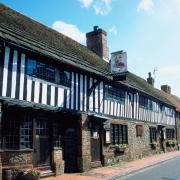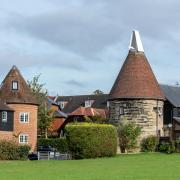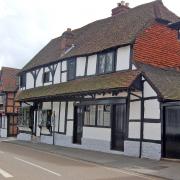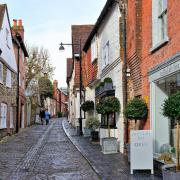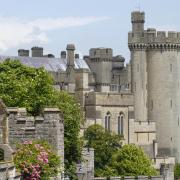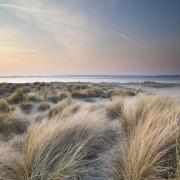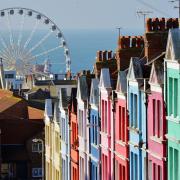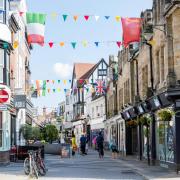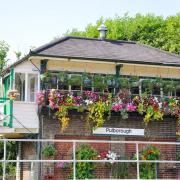A host of Sussex villages glory in cleverly designed signs reflecting their individual nature, several of them inspired by a competition judged by the future King George VI a century ago.

“The village sign has a representation of children dancing in a flower-strewn meadow, and below them are queer figures in relief. One is St Dunstan with his tongs, with which he is pulling the Devil by his nose.”
This description of Mayfield’s village sign, from Arthur Mee’s King’s England: Sussex volume, omits to say its design won an award in a competition launched in 1920. Originally sited near the school, the sign – the tallest in the county – was erected in 1922 and now stands in the High Street.
The art of village signs began in Norfolk. King Edward VII encouraged villagers around the Sandringham Estate to design signs reflecting their individual nature. Often inspired by local history or legend, signs were created at the Queen Alexandra Carving School. Further championed by King George V, new signs were created up until World War I.
Speaking at the Royal Academy of the Arts on 4 May 1920 the Duke of York, later King George VI, suggested a revival of the craft, saying: “I feel sure that many of my comrade motorists would welcome the revival of the village sign or emblem, lettered and conspicuously displayed – a welcome guide to the visitor in a strange land.”

Motoring, a mode of transport but now a leisure activity too, meant people explored far beyond their local area. While motoring organisations had begun installing named signs along major routes, signs at the entrance to towns or villages were yet to come. A keen motorist, the Duke envisaged practical as well as aesthetic benefits to village signs.
The Daily Mail, having established that the Royal Academy did not intend to pursue the suggestion, ran a competition offering prizes for the designers – four major awards of £1,000, £500, £200 and £100 with six special prizes of £50. They would cover the costs of creating and installing prize-winning signs to a maximum of £200, providing a location was agreed in advance. It launched on 14 May and the Duke of York agreed to judge the competition, alongside Sir Aston Webb, president of the RA and Frank Brangwyn RA. Designs would be judged “on appropriateness to their location and appeal to local traditions, history and permanency.”
Entries from amateur and professional artists and architects soon started arriving. By the closing date, 31 July, 550 entries had been received. Their high standard prompted the announcement of an exhibition. To be held at Australia House on the Strand, and featuring 250 designs, it would run for ten days from 15 October, when prize-winners would be announced.
Judged anonymously, designs covered a range of themes such as historical or legendary subjects, heraldic devices and several puns on place names as suggested by the Duke. On 5 October the newspaper published a shortlist of 27 locations for which possible winning designs had been submitted. Four of these were in Sussex although Mayfield was wrongly attributed to Staffordshire at this stage. Final checks were made ensuring a suitable site had been allocated.

The Duke of York announced the winning designs before the envelopes were opened revealing the identity of the artists. A design representing a village in Kent took first prize, but second and third prizes were awarded to Sussex designs. The Mayfield sign, in second place, was the work of Geoffrey Webb, an artist from nearby East Grinstead.
Geoffrey Webb was a young artist who became well-known for his work in stained glass. On the sign, the newspaper reported: “A comely maid hung a daisy chain round a child’s neck; and underneath this delightful group a red devil and a black priest tugged for mastery. This told the tale and derivation of Mayfield.” The black priest is St Dunstan who caught the Devil by the nose with a pair of blacksmith’s pincers. Another derivation of Mayfield, “Open land where mayweed grows,” may account for the flowers in the meadow.
Another young artist, and the only female winner, Dorothy Hutton from Chelsea, took third place with a design for Battle. Sadly this sign has not survived but the newspaper described it in detail. It depicted: “The Battle of Hastings, a well-knit mosaic of many colours, suggestive rather of a stained-glass window of the early Middle Ages.” They later reported Dorothy Hutton who had studied architecture, her work displayed in many important galleries “was more than delighted at having her first sign ‘hung.’” Her design “is historically accurate in regard the soldiers’ uniforms and weapons.”
Mr Charles Tutt JP, chairman of Battle Urban District Council, wrote noting the significance of the award date. “On 14 October 1066 – 854 years ago – the battle of Senlac (Hastings) was fought. On the next day, 15 October (the date of the present exhibition), the dead body of Harold, the last Saxon King, was found almost on the exact spot where, if we are fortunate enough to win in this competition, the sign will be erected.” The owner of Battle Abbey had offered the site in front of the abbey “on ground over which King Harold led his army into the conflict” if a design was successful.

The sign, inscribed, “Battle – Here Was Fought Battle of Hastings 1066,” had sadly deteriorated by World War II when all signage likely to aid an invading force was removed. A new sign of different design was erected in the 1950s in a new location. The present, much simpler interpretation of the Battle, dates from 1977.
The exhibition proved so popular it moved first to Selfridges Palm Court, later touring the country with exhibitions in many locations with art colleges including Wolverhampton and Swansea. Although the results of the Daily Mail competition were declared in October 1920, the signs were not erected until summer 1922. Stanley Dennis, chairman of the parish council unveiled the Mayfield sign on 27 July. The Battle sign unveiling was around the same time.
Village signs continue to be erected in Sussex, often commemorating events such as the Queen’s Jubilees in 1977, 2002 and 2012, and the Millennium.








